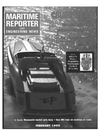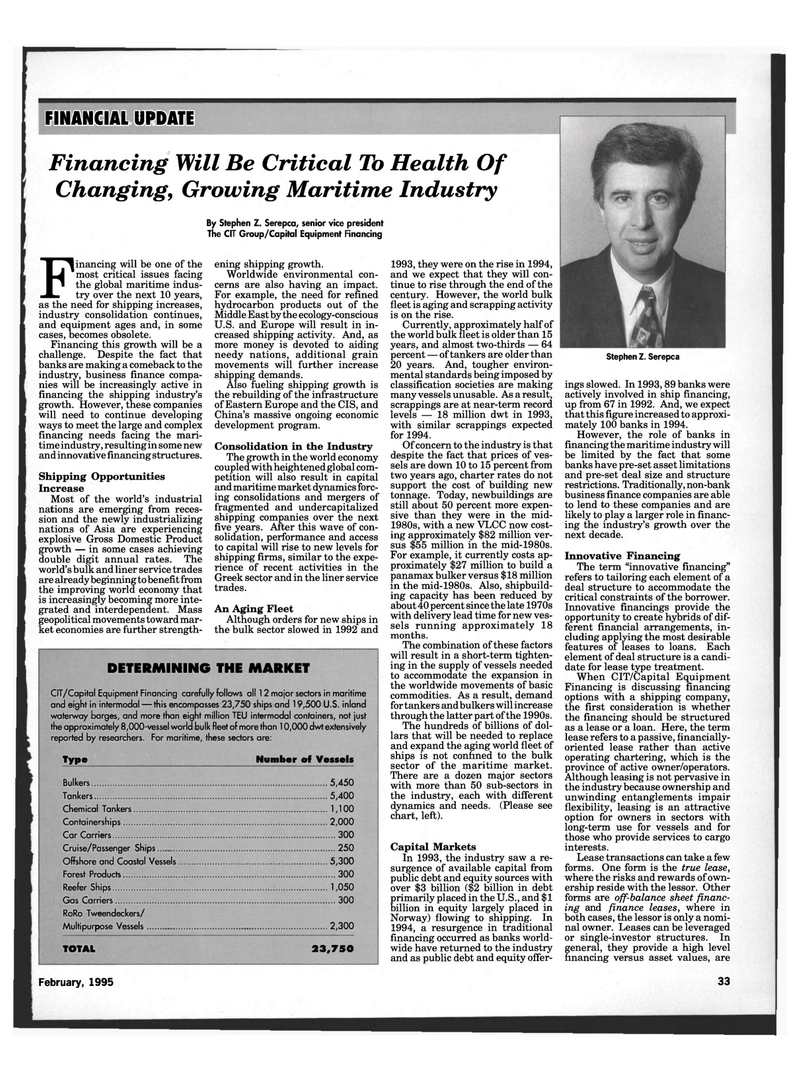
Page 31: of Maritime Reporter Magazine (February 1995)
Read this page in Pdf, Flash or Html5 edition of February 1995 Maritime Reporter Magazine
FINANCIAL UPDATE
Financing Will Be Critical To Health Of
Changing, Growing Maritime Industry
Stephen Z. Serepca
Financing will be one of the most critical issues facing the global maritime indus-try over the next 10 years, as the need for shipping increases, industry consolidation continues, and equipment ages and, in some cases, becomes obsolete.
Financing this growth will be a challenge. Despite the fact that banks are making a comeback to the industry, business finance compa- nies will be increasingly active in financing the shipping industry's growth. However, these companies will need to continue developing ways to meet the large and complex financing needs facing the mari- time industry, resulting in some new and innovative financing structures.
Shipping Opportunities
Increase
Most of the world's industrial nations are emerging from reces- sion and the newly industrializing nations of Asia are experiencing explosive Gross Domestic Product growth — in some cases achieving double digit annual rates. The world's bulk and liner service trades are already beginning to benefit from the improving world economy that is increasingly becoming more inte- grated and interdependent. Mass geopolitical movements toward mar- ket economies are further strength-
By Stephen Z. Serepca, senior vice president
The CIT Group/Capital Equipment Financing ening shipping growth.
Worldwide environmental con- cerns are also having an impact.
For example, the need for refined hydrocarbon products out of the
Middle East by the ecology-conscious
U.S. and Europe will result in in- creased shipping activity. And, as more money is devoted to aiding needy nations, additional grain movements will further increase shipping demands.
Also fueling shipping growth is the rebuilding of the infrastructure of Eastern Europe and the CIS, and
China's massive ongoing economic development program.
Consolidation in the Industry
The growth in the world economy coupled with heightened global com- petition will also result in capital and maritime market dynamics forc- ing consolidations and mergers of fragmented and undercapitalized shipping companies over the next five years. After this wave of con- solidation, performance and access to capital will rise to new levels for shipping firms, similar to the expe- rience of recent activities in the
Greek sector and in the liner service trades.
An Aging Fleet
Although orders for new ships in the bulk sector slowed in 1992 and 1993, they were on the rise in 1994, and we expect that they will con- tinue to rise through the end of the century. However, the world bulk fleet is aging and scrapping activity is on the rise.
Currently, approximately half of the world bulk fleet is older than 15 years, and almost two-thirds — 64 percent — of tankers are older than 20 years. And, tougher environ- mental standards being imposed by classification societies are making many vessels unusable. As a result, scrappings are at near-term record levels — 18 million dwt in 1993, with similar scrappings expected for 1994.
Of concern to the industry is that despite the fact that prices of ves- sels are down 10 to 15 percent from two years ago, charter rates do not support the cost of building new tonnage. Today, newbuildings are still about 50 percent more expen- sive than they were in the mid- 1980s, with a new VLCC now cost- ing approximately $82 million ver- sus $55 million in the mid-1980s.
For example, it currently costs ap- proximately $27 million to build a panamax bulker versus $18 million in the mid-1980s. Also, shipbuild- ing capacity has been reduced by about 40 percent since the late 1970s with delivery lead time for new ves- sels running approximately 18 months.
The combination of these factors will result in a short-term tighten- ing in the supply of vessels needed to accommodate the expansion in the worldwide movements of basic commodities. As a result, demand for tankers and bulkers will increase through the latter part of the 1990s.
The hundreds of billions of dol- lars that will be needed to replace and expand the aging world fleet of ships is not confined to the bulk sector of the maritime market.
There are a dozen major sectors with more than 50 sub-sectors in the industry, each with different dynamics and needs. (Please see chart, left).
Capital Markets
In 1993, the industry saw a re- surgence of available capital from public debt and equity sources with over $3 billion ($2 billion in debt primarily placed in the U.S., and $1 billion in equity largely placed in
Norway) flowing to shipping. In 1994, a resurgence in traditional financing occurred as banks world- wide have returned to the industry and as public debt and equity offer- ings slowed. In 1993,89 banks were actively involved in ship financing, up from 67 in 1992. And, we expect that this figure increased to approxi- mately 100 banks in 1994.
However, the role of banks in financing the maritime industry will be limited by the fact that some banks have pre-set asset limitations and pre-set deal size and structure restrictions. Traditionally, non-bank business finance companies are able to lend to these companies and are likely to play a larger role in financ- ing the industry's growth over the next decade.
Innovative Financing
The term "innovative financing" refers to tailoring each element of a deal structure to accommodate the critical constraints of the borrower.
Innovative financings provide the opportunity to create hybrids of dif- ferent financial arrangements, in- cluding applying the most desirable features of leases to loans. Each element of deal structure is a candi- date for lease type treatment.
When CIT/Capital Equipment
Financing is discussing financing options with a shipping company, the first consideration is whether the financing should be structured as a lease or a loan. Here, the term lease refers to a passive, financially- oriented lease rather than active operating chartering, which is the province of active owner/operators.
Although leasing is not pervasive in the industry because ownership and unwinding entanglements impair flexibility, leasing is an attractive option for owners in sectors with long-term use for vessels and for those who provide services to cargo interests.
Lease transactions can take a few forms. One form is the true lease, where the risks and rewards of own- ership reside with the lessor. Other forms are off-balance sheet financ- ing and finance leases, where in both cases, the lessor is only a nomi- nal owner. Leases can be leveraged or single-investor structures. In general, they provide a high level financing versus asset values, are
DETERMINING THE MARKET
CIT/Capital Equipment Financing carefully follows all 12 major sectors in maritime and eight in intermodal — this encompasses 23,750 ships and 19,500 U.S. inland waterway barges, and more than eight million TEU intermodal containers, not just the approximately 8,000-vessel world bulk fleet of more than 10,000 dwt extensively reported by researchers. For maritime, these sectors are:
Type Number of Vessels
Bulkers 5,450
Tankers 5,40
Chemical Tankers 1,10
Containerships 2,000
Car Carriers 30
Cruise/Passenger Ships 25
Offshore and Coastal Vessels 5,300
Forest Products 30
Reefer Ships 1,05
Gas Carriers 0
RoRo Tweendeckers/
Multipurpose Vessels 2,30
TOTAL 23,750
February, 1995 33

 30
30

 32
32
